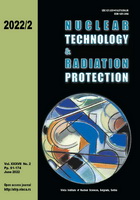
COMPARISON OF CALIBRATION FACTORS FOR FIELD-CLASS DOSIMETERS
Pages: 103-110
Authors: Miloš Z. Živanović, Amra F. Šabeta, Nikola Lj. Kržanović, Vedrana D. Makarić, Miloš V. Djaletić, Milica R. Stupar, and Srboljub J. StankovićAbstract
This paper presents a comparison performed between two calibration laboratories in several radiation qualities, using dosimeters of varying quality as transfer instruments. The goal of this work was to investigate the viability of using field-class dosimeters for official comparisons and to determine if the calibration factors for field-class dosimeters are comparable between calibration laboratories within the stated measurement uncertainties. The results of the comparison were acceptable for high-quality electronic personal dosimeters in all radiation qualities, and such dosimeters could be used as transfer instruments. On the other hand, comparison results for low-quality dosimeters were often not acceptable, either due to pronounced energy dependence, low stability, or both. Such instruments are unreliable even under well-defined laboratory conditions, and their use in routine measurements may cause doubt in official data or influence public opinion. This problem is often hidden because many dosimeters are calibrated or verified only in 137Cs beams, where the deviations are the smallest. The largest differences are found for low-energy X-ray radiation qualities, where many dosimeters have significant overresponse.
Key words: dosimetry, comparison, energy dependence, stability, calibration, ambient dose equivalent, personal dose equivalent
FULL PAPER IN PDF FORMAT (1,07 MB)
